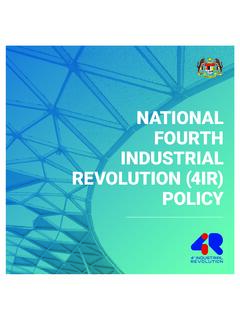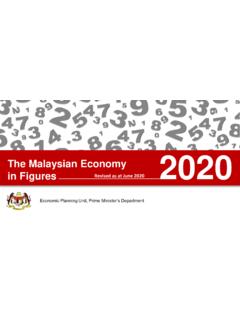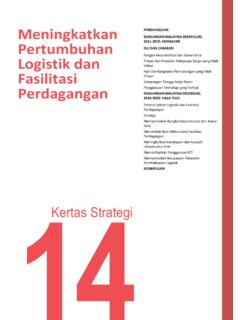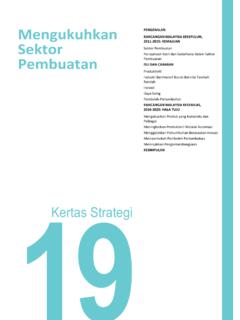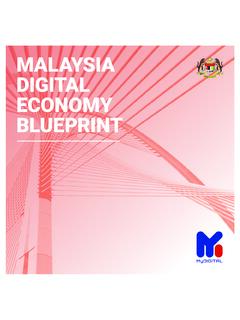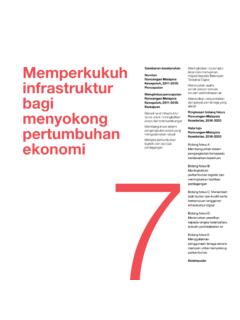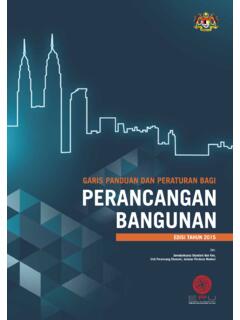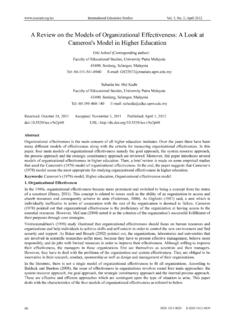Transcription of GOVERNMENT OF MALAYSIA - EPU
1 1 GOVERNMENT OF MALAYSIA MALAYSIA SUCCESS STORY IN POVERTY ERADICATION Prepared By 2 INTRODUCTION MALAYSIA is a unique country. It is made up of multi-ethnic and multi-cultural society who lives in peace and harmony. Three major ethnic groups are Malays and other Bumiputera group, Chinese and Indians. In 1970, Malays and other Bumiputera who made up about per cent of the total population, the Chinese per cent, Indians per cent and others per cent. Although MALAYSIA is a multi-racial country, all Malaysians live in harmony and conflict among ethnic group is rare.
2 The harmonious society and its diversity have driven the development and nation building. In fact, MALAYSIA has been recognized by the world as a model for other plural societies. MALAYSIA S SOCIO-ECONOMIC BACKGROUND Federation of Malaya secured its independence from Britain on 31 August 1957. After achieving independence in 1957 but prior to 1970, the development policy was primarily aimed at promoting growth with strong emphasis on the export market. The approach was laissez faire (market-based policy with no interference by the GOVERNMENT ) as well as on economic and rural development.
3 Prior to independence, more than half of the Malaysian households were living in poverty. Although the economy registered high growth rates during 1960s, (average growth of GNP at 3 percent), the country continued to face high poverty incidence in both rural and urban areas. The overall incidence of poverty in 1970 was per cent. The incidence of poverty in rural areas was higher at per cent as compared to urban areas at per cent. The incidence of poverty among the Bumiputera (Malays and other indigenous groups) was higher at per cent, while for the Chinese was 26 per cent and Indian per cent.
4 The overall income inequality in 1970 was high with Gini coefficient of and income share of the bottom 40% household was low at per cent as compared to top 20 per cent household at per cent. The country also experienced high unemployment rate which recorded at percent in 1967 and high at percent in 1970. There were also economic imbalances between urban and rural areas as well as between indigenous and non-indigenous groups. The large part of population, particularly among the indigenous groups were living in the rural areas and engaged in the low income, traditional activities particularly in rice and rubber smallholding in the agriculture sector.
5 Whereas, the non-indigenous among the Chinese and Indians have entered the sectors that were very dynamic such as tin mining, agriculture estates, commerce and manufacturing. 4 NEW ECONOMIC POLICY (NEP), 1971-1990 PERIOD In the implementation of development initiatives, MALAYSIA has subscribed strongly to the belief that economic development must benefit all citizens and reduce the disparity. Therefore, the development thrust after independence was centred on the philosophy of growth with equity . This development philosophy has been translated through the promulgation of the New Economic Policy (NEP) in 1971 under MALAYSIA s first long-term development plan, 1971-1990 to support and strengthen the GOVERNMENT s effort to drive the economy towards promoting quality and inclusive growth to ensure that no one in the society will be left out in the development process.
6 The objectives, priorities and strategies under the NEP had been shaped to achieve the over-riding goals of national unity and develop a just, prosperous and progressive Malaysian society. The NEP was implemented through two pronged strategies: (I) Eradication of poverty irrespective of race; and (ii) Restructuring of society so as to eliminate ethnic identification with economic functions. The main focus under the poverty eradication strategy has been on income-generating, expansion of education and training facilities, employment generation, and modernisation of rural life as well as improvement in living conditions.
7 Provision of services to the poor has also been done through GOVERNMENT partnerships 5 with the private sector and NGOs. During the first half of the NEP period, agricultural policy through agrarian reform has been the major instrument in transforming rural areas and the poverty-stricken communities into a more prosperous Malaysian society. Since the majority of the poor were in the agricultural sector in rural areas, the focus of the poverty eradication strategy was on mobilizing rural resources through land development programmes and reorganizing institutions towards modernizing and developing the agriculture and rural sector.
8 Among other programme were: i. New land development schemes - The resettlement of the poor and the landless in the new land development schemes (rubber and oil palm plantation.) The settlers have been provided with house and other facilities such as electricity and water supply; ii. In-situ development programme - Rehabilitation and consolidation of land, replanting with commercially higher-yielding crops and the application of modern agriculture techniques; iii. Promoting downstream agriculture activities through village industry and rural entrepreneurship programme; iv.
9 Double-cropping or off-season cropping, intercropping and mixed farming to supplement main crop incomes; v. Improve marketing network through the establishment of farmers markets in urban centres to enable farmers to sell their products directly to the customers with better prices; 6 vi. Technical training and advisory on agriculture best practices to the target groups and the rural poor; and vii. Providing industrial and vocational training for the rural human capital, coupled with credit facilities and related support, to enable them to be employed in non-farm occupations or start their own businesses in rural areas and urban centres; Apart from income-generating projects, the GOVERNMENT has also sought to improve the quality of life of the poor through the provision of infrastructural and social amenities as part of a broader programme to improve the quality of life of all Malaysians.
10 For the rural population, that includes the provision of potable and piped water, electricity, roads, medical and health services, and schools including rural hostels. A special programme for the hardcore poor (household earning less than the food PLI) was also continued. This programme involved the creation of a register and profile of hardcore poor households and the delivery of appropriate projects to meet their specific needs, such as additional opportunities to increase their employability and income, better housing, food supplements for children and educational assistance.
